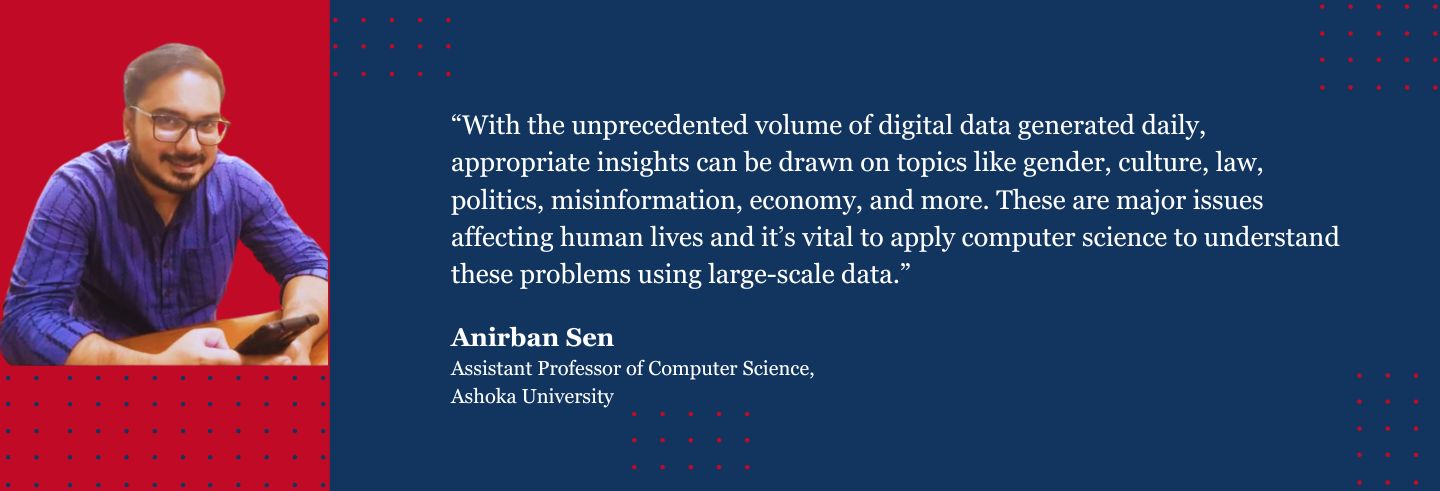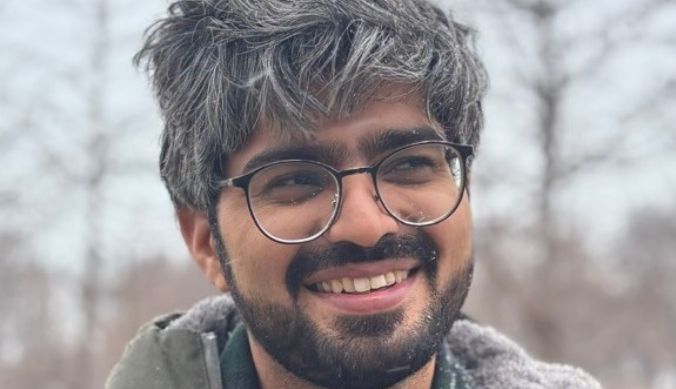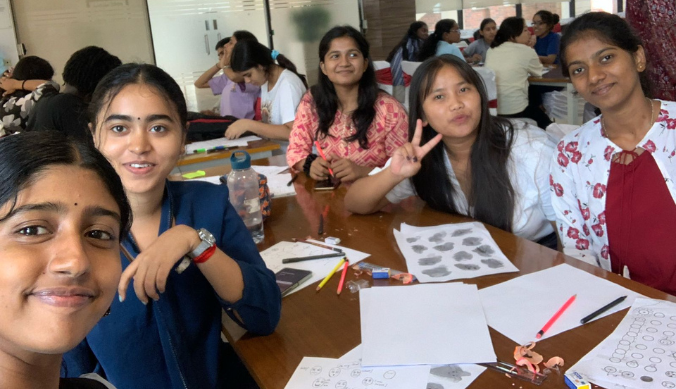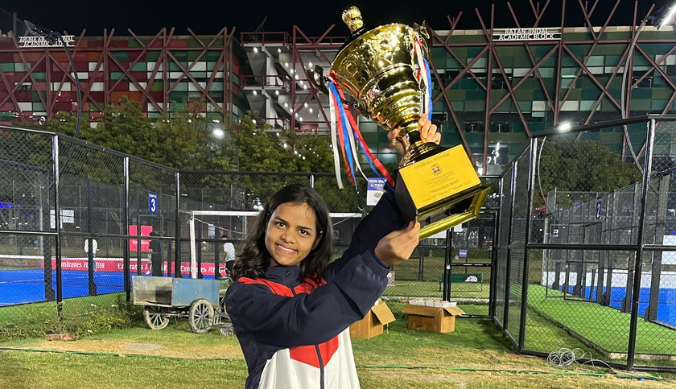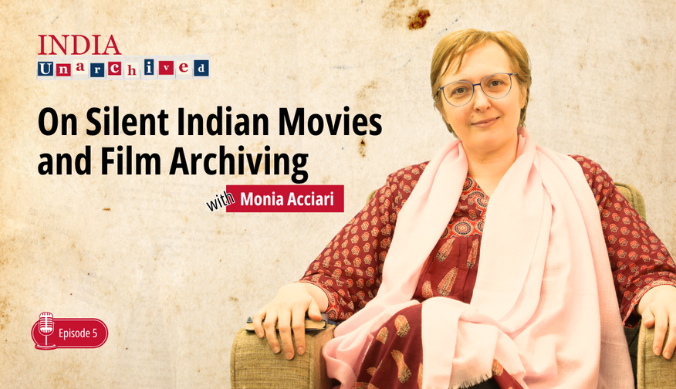Many of the world’s most pressing problems can be solved through interdisciplinary collaboration
Dr. Anirban Sen, the newest member of Ashoka University’s Department of Computer Sciences, shares his work on analysing India's media landscape and emphasises the importance of interdisciplinary research, leveraging computer science to address societal challenges
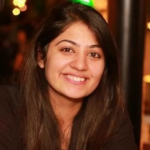
Yukti Arora
30 April, 2024 | 5m readSatyajit Ray’s famous creation, Professor Shanku, sparked Anirban Sen’s interest in science. Anirban, an Assistant Professor of Computer Science (CS) at Ashoka University, initially never considered a career in Computer Science. However, he chose the field initially for its promising job prospects. His genuine interest in Information Technology emerged in college when he learned programming and discovered CS as an active area of research. It was during his Master’s that Anirban was introduced to Natural Language Processing (NLP) and media analysis, which became central to his research focus.
He continued his academic journey with a Ph.D. in Computer Science, during which he was introduced to Computational Social Science (CSS). His advisor once told him, “there are hundreds of problems that are immediately relevant to society. You just have to read a newspaper to know which ones!” The statement stayed with him guiding his research focus in the CSS domain. He explains that CSS is an interdisciplinary field that operates at the intersection of CS, social sciences, and political sciences. A research focus in CSS provided him the opportunity to address pressing societal issues through computer science.
‘The most pressing problems in the world await solutions, and these solutions require the active sharing of ideas, tools, and methods across multiple disciplines. Interdisciplinary research gains its importance from this need. Problems in various domains like Applied Biology, Astrophysics, Cognitive Science, Economics, Social Sciences, and Political Sciences (to name a few) demand the attention of interdisciplinary researchers. Additionally, Anirban believes that achieving each of the 17 Sustainable Development Goals requires increased collaboration among experts from various fields. ‘This collaboration could benefit the marginalized communities worldwide and promote overall development’, he emphasized, highlighting the importance of interdisciplinary research and collaboration.
Reflecting on his time as a postdoctoral fellow at Microsoft Research India, Anirban spoke about his experience working with the Technology for Empowerment (TEM) team. His work at MSRI enhanced his understanding of how misinformation and hate speech communities operate, evolve, and overlap over time.
Elaborating on his future research plans, Anirban explains, “Media is one of the richest sources of information on development, policy, and society. It plays a key role in shaping and influencing public opinion. My exposure to large scale data analysis spawned from my affinity to study media data. I have worked extensively on Political Economy analysis using media data, and on analysis of misinformation and propaganda in social media. I intend to carry these threads forward to Ashoka”.
Anirban’s research at Ashoka University focuses on building a Knowledge Base (KB) from large-scale data collected from Indian web-based mass media sources. This work will facilitate the analysis of the media landscape in India, providing policy researchers, journalists, academicians, students, and citizens gain an authentic overview of socio-political events across the country. He stresses the importance of using these computational methods to study societal challenges, such as the case of the COVID-19 pandemic, where millions were adversely affected by the spread of fake news. He is also interested in audio-based deep-fake detection, climate study using computational methods, and web data analysis around health.
“With the unprecedented volume of digital data generated daily, appropriate insights can be drawn on crucial social science topics like gender, culture, law, politics, migration, democracy, privacy, security, misinformation, economic growth, and inequality. These are major issues affecting human lives but have received limited attention in traditional CS research until recently. It’s vital to apply computer science and engineering methods to understand these problems using large-scale data’, he shared.
Anirban acknowledged the challenges of his research, which include data accuracy, gaps, cleaning, deduplication, when collecting data from various sources. Addressing these hurdles involve relying on established methods and conducting bottom-up studies to measure the social impact of developed solutions.
His commitment to continuous learning keeps him motivated. What brought him to Ashoka?
“Ashoka University is a unique hub for interdisciplinary research and promotes an environment that actively encourages research collaboration across departments. Having worked in an interdisciplinary research area (CSS) for some time now, it will provide me a platform to perform and promote my research effectively. Moreover, the University through its state-of-the-art facilities and research funding acts as a source of inspiration for researchers like me to explore newer directions of work. While most of my research previously has been in the media space, I am looking forward to collaborating with multiple other departments to explore areas like computational biology, climate and environmental studies.”
“The supportive and knowledgeable colleagues within the CS Department and beyond, make teaching and research enjoyable. Finally, I have till date formed some of my best moments in the classrooms at Ashoka, where the dynamic group of intelligent and forever curious students make teaching and research an effervescent experience. I’m excited to be part of this vibrant research community and pursue impactful work.”
(Interview Conducted by Dr Yukti Arora, Senior Manager RDO; Edited by Kangna Verma)
Study at Ashoka







